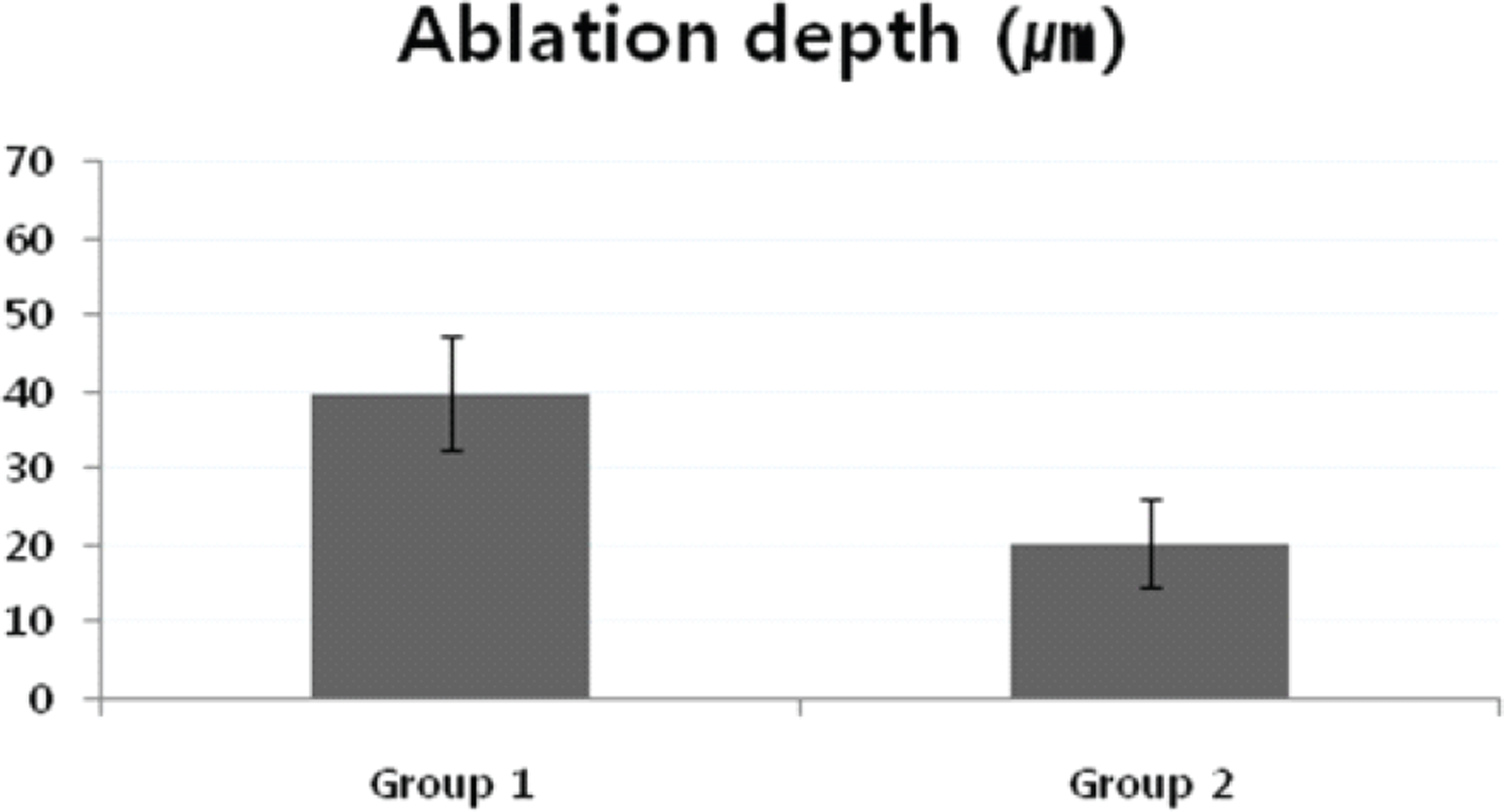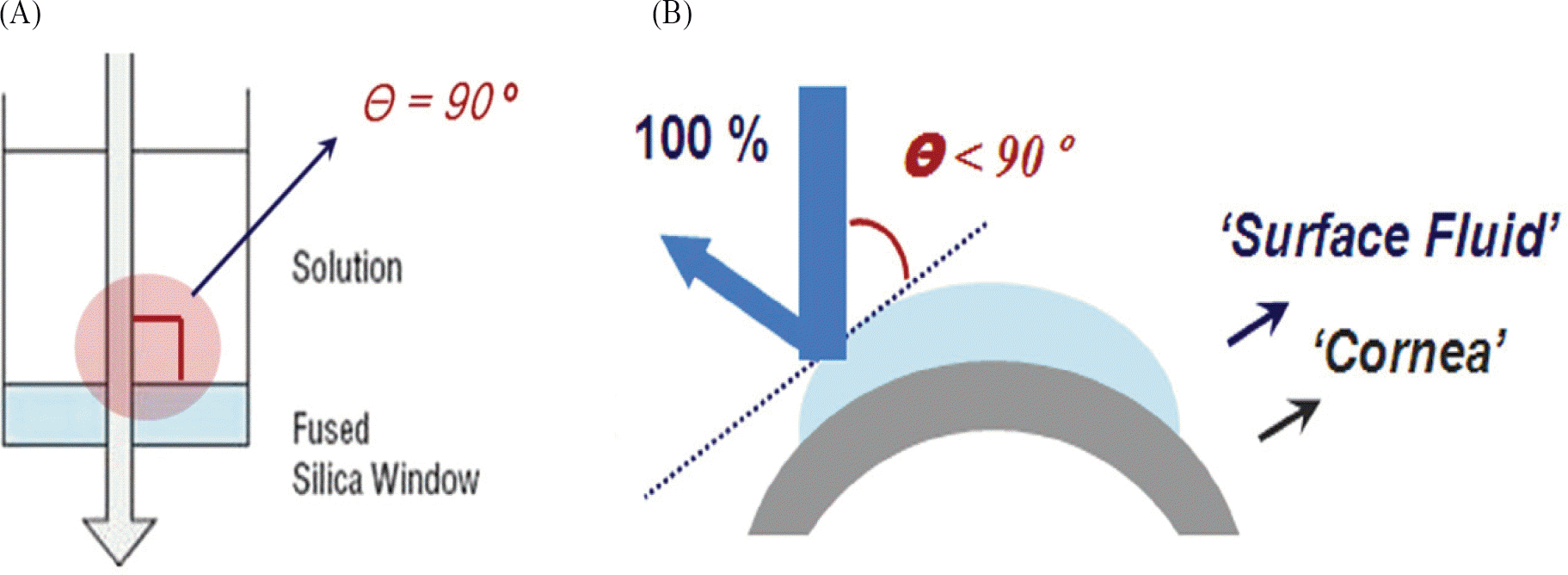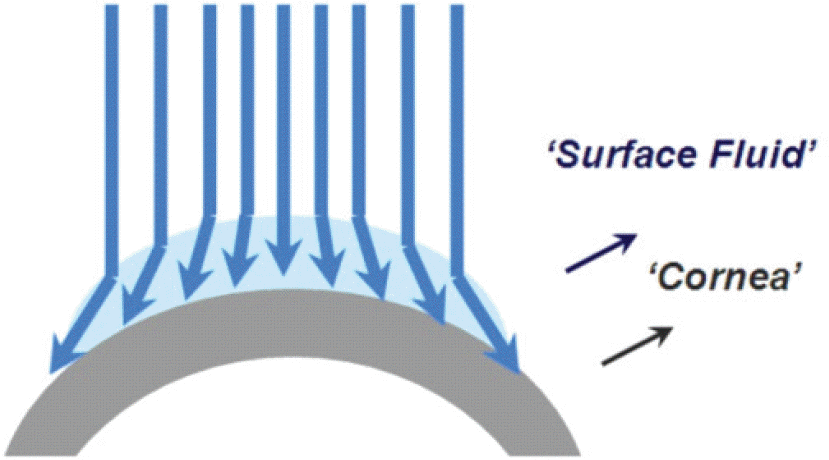Abstract
Purpose
To investigate the effect of surface fluid on the ablation rate and efficacy of 213-nm solid-state laser during photorefractive keratectomy (PRK).
Methods
Twelve rabbits (24 eyes) underwent myopic PRK for the correction of 10 diopters using 213-nm solid-state laser. Photoablation was performed with removal of corneal surface fluid using the Weckcel® sponge every 5 seconds in one eye and without removal of corneal surface fluid in the control eye. The mean central corneal thickness (CCT) was evaluated preoperatively, and at 1 week, 4 weeks postoperatively.
Results
The mean CCT of group 1 (with removal of corneal surface fluid) were 361.3±13.9 µm preoperatively and 321.4±18.5 µm at 4 weeks postoperatively. The mean CCT of group 2 (without removal of surface fluid) were 358.7±8.9 µm preoperatively and 338.4±12.0 µm at 4 weeks postoperatively. The mean ablation depths were 39.8±7.4 µm in group 1 and 20.3±5.8 µm in group 2 at 4 weeks postoperatively ( p<0.05).
References
1. Ediger MN, Pettit GH, Matchette LS. In vitro measurements of cytotoxic effects of 193nm and 213nm laser pulses at subablative fluences. Lasers Surg Med. 1997; 21:88–93.
2. Dair GT, Pelouch WS, Van Saarloos PP, et al. Investigation of corneal ablation efficiency using ultraviolet 213-nm solid state laser pulses. Invest Ophthalmol Vis Sci. 1999; 40:2752–6.
3. Ren Q, Simon G, Parel JM. Ultraviolet solid-state laser (213-nm) photorefractive keratectomy: in vitro study. Ophthalmology. 1993; 100:1828–34.
4. Ren Q, Simon G, Legeais JM, et al. Ultraviolet solid-state laser (213-nm) photorefractive keratectomy: in vivo study. Ophthalmology. 1994; 101:883–9.
5. Tsiklis NS, Kymionis GD, Kounis GA, et al. Photorefractive keratectomy using solid state laser 213nm and excimer laser 193nm: A randomized, contralateral, comparative, experimental study. Invest Ophthalmol Vis Sci. 2008; 49:1415–20.
6. Dougherty PJ, Wellish KL, Maloney RK. Excimer laser ablation rate and corneal hydration. Am J Ophthalmol. 1994; 118:169–76.

7. Fields CR, Taylor SM, Barker FM. Effect of corneal edema upon the smoothness of excimer laser ablation. Optom Vis Sci. 1994; 71:109–14.

8. Campos M, Wang XW, Hertzog L, et al. Ablation rates and surface ultrastructure of 193nm excimer laser keratectomies. Invest Ophthalmol Vis Sci. 1993; 34:2493–500.
9. Dair GT, Ashman RA, Eikelboom RH, et al. Absorption 193- and 213-nm laser wavelengths in sodium chloride solution and balancedsalt solution. Arch Ophthalmol. 2001; 119:533–7.
10. Lembares A, Hu X-H, Kalmus GW. Absorption spectra of corneas in the far ultraviolet region. Invest Ophthalmol Vis Sci. 1997; 38:1283–7.
11. Ito T, Ito A, Hieda K, Kobayashi K. Wavelength dependence of inactivation and membrane damage to Saccharomyces cerevisiae cells by monochromatic synchrotron vacuum-UV radiation (145-190-nm). Radiat Res. 1983; 96:532–48.
12. Hieda K, Ito T. Action spectra for inactivation and membrane damage of Saccharomyces cerevisiae cells irradiated in vacuum by monochromatic synchrotron UV radiation (155-250-nm). Photochem Photobiol. 1986; 44:409–11.
13. Munakata N, Hieda K, Kobayashi K, et al. Action spectra in ultraviolet wavelengths (150-250-nm) for inactivation and mutagenesis of Bacillus subtilis spores obtained with synchrotron radiation. Photochem Photobiol. 1986; 44:385–90.
14. Kornmehl EW, Steinert RF, Puliafito CA. A comparative study of masking fluids for excimer laser phototherapeutic keratectomy. Arch Ophthalmol. 1991; 109:860–3.

15. Förster W, Grewe S, Atzler U, et al. Phototherapeutic keratectomy in corneal diseases. Refract Corneal Surg. 1993; 9:S85–90.

Figure 1.
The photograph of photorefractive keratectomy using 213-nm solid-state laser in rabbit’s eye.

Figure 2.
The comparison of ablation depth at postoperative 4 weeks ( P-value<0.05, Mann-Whitney test).

Figure 3.
Schematic presentation of reflection loss. (A) Experimental model of Geoffrey et al8 (θ=90°). (B) Reflection loss on corneal surface fluid (θ<90°).

Table 1.
The comparison of central corneal thickness at preoperative, postoperative 1 week and 4 weeks
| Central corneal thickness (µm) | ||
|---|---|---|
| Group 1 (Fluid removed) | Group 2 (Not removed) | |
| Preoperative | 361.3±13.9 | 358.7±8.9 |
| Postoperative 1 week | 358.6±13.5 | 359.8±7.9 |
| Postoperative 4 weeks* | 321.4±18.5 | 338.4±12.0 |




 PDF
PDF ePub
ePub Citation
Citation Print
Print



 XML Download
XML Download